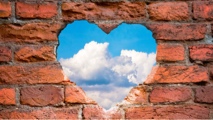
About the only wall we hear about in the news media is the one that hasn’t yet gone up along the Texas-Mexico border. Given the split House of Representatives, it is now more unlikely to be built. But that is not the wall we should be worried about. There are other walls being constructed silently that are much more dangerous to health of the body politic. One is the wall formed by the huge economic gap between the super-rich and the rest of us. It’s not the old story about the rich and the poor, but a about a tiny group of people that have gathered in the bulk of the wealth. Here’s a few statistics from a Wikipedia article about inequality:
Just prior to President Obama’s 2014 State of the Union Address, media reported that the top wealthiest 1% possess 40% of the nation’s wealth; the bottom 80% own 7%; similarly, but later, the media [NYT] reported, the “richest 1 percent in the United States now own more additional income than the bottom 90 percent”. The gap between the top 10% and the middle class is over 1,000%; that increases another 1,000% for the top 1%. The average employee “needs to work more than a month to earn what the CEO earns in one hour.” Although different from income inequality, the two are related. In Inequality for All—a 2013 documentary with Robert Reich in which he argued that income inequality is the defining issue for the United States—Reich states that 95% of economic gains went to the top 1% net worth (HNWI) since 2009 when the recovery allegedly started. More recently, in 2017, an Oxfam study found that eight rich people, six of them Americans, own as much combined wealth as half the human race. . . According to PolitiFact and others, in 2011 the 400 wealthiest Americans have more wealth than half of all Americans combined.
Most of this wall is invisible, but shows up in the power of this group to control the life of the rest of us through corporate power and influence (many would say manipulation) of the government. The American Dream is just that, a dream. The careful research of the sociologist, Robert Putnam, starkly reports, in Our Kids the barriers faced by the poor in the US to rise up out of their hole in the political economy, lacking schools, jobs, and social capital. The ultimate irony of this situation is that, as a result of the last round of Republican’s tax cuts, the barrier is growing, further trapped the core of President Trump’s base behind it. Like the barrier at the border, this wall can be lowered through policy and a more benign corporate structure. The speed depends on the level of commitment and so-called political will.
Another wall is separating one American from another as the President’s political rhetoric drives a wedge between what have become the hard edges of partisanship in the US. Like a flu epidemic, his divisive rhetoric is infecting the political system, and beyond to the culture. We are not governed by a parliamentary system where a multiplicity of parties permit sharp differences to exist, differences that become blurred by the need to form majority coalitions. Our two-party system cannot work without the ability to reach compromises, especially when the party that controls is in the minority as it is today. The strange electoral system in the US permits this by the way the Senate and the Presidency are chosen. Gerrymandering only exacerbates this.
From the beginning, the Founding Fathers realized that primary schismatic forces present in England, religion and Monarchism, could not be allowed to overwhelm the attractive force of their promises for the new nation: freedom and justice for all. The “all” is essential. Without that promise to all, America can make no claims to the exceptionalism that forms both our identity and culture. The cultural/political wall that is being constructed does not need Congressional approval or require taxpayer’s funds, but it is chewing up the nation’s wealth as an untold rate. Again, Bob Putnam comes to mind as he connects the disappearing comity at both community and national levels to a loss of social capital. I am sure, if some clever economist would convert this loss to dollars, it would be an astounding figure.
This is the wall I fear most. This wall impels the shooters who think they are trapped on the wrong side to try to escape through the imaginary holes their gunfire creates. The wall of concrete and barbed wire, should it actually be built, can be razed in a minute, a lesson we have learned from the sudden disappearance of the Berlin Wall, separating two nations. The invisible wall between Americans will be much more difficult to tear down, once firmly in place.
The powerful voices that are building it must stop. It is not realistic to expect this President to stop, but one hopes that the Congress of 535 men and women might collectively begin to see the damage and act to pull the Country together. One also might hope to hear the clergy of all religious callings to stop taking sides from the pulpit. What could be more important to the God they invoke that a coming together to celebrate the miracle of life?
President Reagan had it right when he demanded Gorbachev to “Tear down this wall.” Who will be next to have the vision and courage to take down the walls that are tearing us apart?